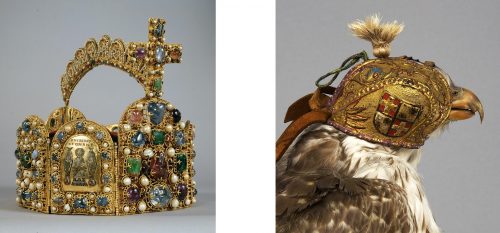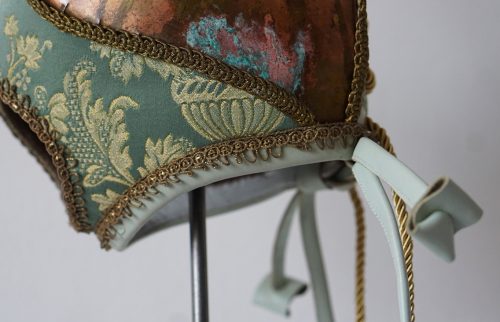My work ‘pennae’ has been selected as one of three winning artworks for the prize competition
„Manifestation of Secular and Spiritual Power“ and will soon be displayed at the ‘Kunstkammer’ at ‘Kunsthistorisches Museum Vienna (KHM)’.
The competition already took place in 2019 and was announced by the ‘Kunsthistorisches Museum Vienna’ in collaboration with the ‘Academy of Fine Arts Vienna’ and the ‘Association for intergenerational funding of art and culture’. The show juxtaposes the ‘Imperial Crown of the Holy Roman Empire’ (Reichskrone), kept at the ‘Imperial Treasury’ (Kaiserliche Schatzkammer) and the ‘Vienna Gregory tablet’ (Gregorplatte) – both thousand-year-old icons of European art history – with the works of the students and recent graduates Theodor Maier, Yul Koh & Sophie Anna Stadler and myself.
The exhibition ‘Maybe manifested’ will take place in between 09.04.2021 and 15.08.2021.
Due to the current restrictions there will be no opening reception.
Facebook Event: https://www.facebook.com/events/545508939757810/
~
My installation work ‘pennae’ examines the symbolism of insignia and their function as a legitimisation of class, status and territory.
„Nature itself becomes the medium, its utilization and transformation, its domestication serves as an orchestration of sovereignity,
and the visualization of the claim of power.“ 1
lat. ‘pennae’ (Engl.: Feathers, the plumage of a bird ; German: Gefieder)
–
“In memory of a forgotten augur — might she have forseen the end of all empires? Her metallic feathers comb the skies to sound and beat the claim to power with her wings, and to worship the birds as the true rulers over our imagination.” Lona Gaikis (czirp czirp)
–

© Patrizia Ruthensteiner
A cluster of wings encircles two surmounted crowns of the holy virgin and her child. The headpiece is comprised of 28 wings from different regions.
It hides the wearer’s identity and makes eye contact impossible between them and the spectator.
The symbolism used in the distinctive headdresses of ancient deities has not only served as a demonstration of the rulership over a certain territory,
but it also promoted the embodiment of the desirable features and characteristics associated with the respective materials used.

© Patrizia Ruthensteiner
Eight flanking falconry hoods designed to be worn by humans are representatives for the eight picure-plates of the ‘Imperial Crown’.
Each hood features a different crown sculpted from patinated copper, brass or steel. Once they are put on, the vision of the wearer is obscured, while hearing the sound of the metal springs (German: Metallfedern (Engl.: metal feathers)) attached to a membrane and integrated into the crowns. The pieces will be mute in this exhibition. The falcon is celebrated as the aristocrat of the sky, as a messenger between heaven and earth, as a mediator between the profane and the sacred who flies across the boundaries separating this world from the next.
The purpose of a Falconry hood is to keep a raptor in a calm state during manning processes, which is described as an acclimatization to the human world.
The book ‘De arte venandi cum avibus’ (Engl.: About the art of hunting with birds) written by Friedrich II. In 1241 – 1248 is considered as an essential work of ornithologic knowledge, but also of art-historic importance.
„Aristocratic hunting marks a strictely regimented and priviledged access to natural resources. Christina Joanaz De Melo charcterizes this regimentation, the allocation or the withholding of hunting rights, as an important instrument of social distinction and the demonstration of sovereignity.“ 1

Left: Imperial Crown, 2. Half 10th century, adding of the crown-cross: early 11th century
© Kunsthistorisches Museum Vienna, Kaiserliche Schatzkammer
Right: Falconry hood, Nothern Italian between 1494 and 1508, gift of Kaiser Maximilian I (1459-1519)
to his second wife Bianca Maria Sforza (1472-1510) © Kunsthistorisches Museum Vienna, Hofjagd- und Rüstkammer
~
~1 (Knoll Martin, Dominanz als Postulat – Natur und Gesellschaft im Absolutismus, in: Umwelt und Herrschaft in der Geschichte /
Environment et pouvoir: une approche historique, hrsg. Von Francois Dueeppe-Lamarre und Jens Ivo Engels, München 2008)
Thanks for the support to Stefan Voglsinger (Setzkasten Wien), Lona Gaikis (czirp czirp), Wolfgang Salomon,
Ilayda Hazneci, Lisa-Maria Ernst, Mael Blau, Geflügel Weiß, Wagramgeflügel, Anna Ruthensteiner, Judith Ruthensteiner,
Kunsthistorisches Museum Vienna, Academy of Fine Arts Vienna
~







